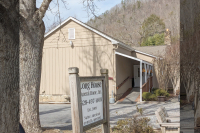Celebrating a century
Book details Carolina Mountain Club’s 100-year history
Transformation on trail: Volunteers converge to secure Max Patch’s future
On a sunny Saturday in September, tall grasses wave a fringe atop Max Patch, framing mountain layers fading from ripened green to hazy blue. Blooming heads of goldenrod and aster dot the slope, a brisk wind whisking autumn chill into the sun-warmed air. Slope and shrubbery combine to create pockets of privacy on the open bald, fostering an illusion of wilderness that’s broken only when the white-blazed trail brings two travelers together.
It’s a wholly different scene than the one that sprawled across the mountaintop just one year ago, when Asheville artist Mike Wurman flew his drone over the bald to capture what became a viral image of 130 tents blanketing a trampled-down Max Patch.
Hiking through history: Little Cataloochee offers a window to the past
One hundred years ago, the parking area and campground just past the fields in Cataloochee Valley where elk often hang out was better known as Nellie, a remote community in what is now the Great Smoky Mountains National Park.
As anybody who’s ever driven the steep and narrow access road from Jonathan Creek can imagine, it was hard to get in and hard to get out in the days when horsepower came mainly from actual horses. People didn’t have much, partly because of how difficult it was to transport outside goods up and over the ridge.
Symbol of connection: A decade of collaboration yields 300-mile MST trail section
From towering mountains to shimmering seas, North Carolina has a little bit of everything — and for the trail that ties it all together, a major milestone has just been marked.
On Wednesday, Oct. 3, trail volunteers, government officials and natural resources workers from across the state gathered at Oconaluftee Visitor Center in the Great Smoky Mountains National Park near Cherokee to celebrate completion of a 300-mile section of the Mountains-to-Sea Trail, starting at Clingmans Dome and ending at Stone Mountain State Park in Allegheny and Wilkes counties.
Carolina Mountain Club challenges hikers to seek views from the top
By Peter Barr • Guest writer
The Carolina Mountain Club is challenging hikers to seek out some of Western North Carolina’s most spectacular panoramas. The group’s new Lookout Tower Challenge rewards outdoor enthusiasts for completing hikes to 24 of the region’s mountaintop lookout towers.
Lookout towers began popping up on mountain peaks in the early part of the 20th century. Most were constructed by the Civilian Conservation Corps. Used for rapid fire detection, men and women were stationed in isolated areas to scan the horizon for smoke and fire. Quick discovery and fast reporting helped to prevent small blazes from developing into ravaging forest fires. Most lookouts were erected in national forest and park lands where wildfires could spread quickly.
Fire tower use began to decline by the 1960s and 1970s when airplanes became the preferred method of fire detection. Aerial observation was more efficient and detection was far more expansive, eliminating the need for a network of smoke watchers and the funding to maintain their towers. Most towers were decommissioned by the 1980s.
No longer standing guard over the forests, remaining towers now offer hikers the opportunity for dramatic panoramic views. With the majority of Southern Appalachian peaks forested, a hike to the top of a mountain does not always reward with a view. Lookout towers offer the ability to climb above the tree canopy and bask in the majesty of the surrounding landscape.
The Lookout Tower Challenge gives hikers an added impetus to make the treks to these historic relics dotting the region’s peaks. It’s one of several hiking challenges run by the Carolina Mountain Club — from a peak-bagging circuit that sends hikers to every 6,000-foot mountain to a line-up of 100 waterfalls.
The hiking challenges allow hikers to build a repertoire of memorable outdoors experiences. Each hike is an added piece to a collection, and the pursuit makes the challenges addicting. For some, they are difficult to resist.
“The challenges give us an excuse to journey to the backcountry when we otherwise may find an excuse not to go,” said Michael Booker, of Knoxville, Tenn. Challenge programs attracted him and his wife, Jennifer, to the club.
After a five-year pursuit, they finally knocked out the South Beyond 6,000 circuit of 6,000-foot peaks. They began tackling the Lookout Tower challenge last November and have finished 21 of the 24 towers so far.
“It seemed like an attainable goal,” said Booker. “It offers the opportunity to explore diverse parts of the southern Appalachian backcountry that we otherwise may not have visited. Many of the mountains offer physical and mental challenges that in the end are rewarded with limitless views.”
Booker and his wife enjoy pursuing a common goal together. But when asked the single greatest reason they were lured by the LTC, he didn’t hesitate: “the views”.
Those wishing to revel in the beauty slightly longer, several fire towers have overnight camping spots nearby. Mt. Sterling, in the Haywood County section of the Great Smoky Mountains National Park, features a backcountry campsite, which was once the site of the tower keeper’s cabin removed in the 1980s. Wesser Bald, in the Nantahala National Forest and along the Appalachian Trail, also features a campsite. Camping by the towers gives backpackers the opportunity to witness spectacular sunsets and sunrises a short jaunt from their tent.
Lookout towers in need
No longer used for fire detection, many of the region’s lookout towers have been forgotten. While the challenge features 24 towers, about 40 lookouts are still standing in Western North Carolina. Many have deteriorated into an unsafe condition and had to be excluded. Even more towers have been removed entirely. More than 80 lookouts once dotted the region’s peaks. Neglected beyond repair, their views and history are gone forever.
The Carolina Mountain Club hopes the program will not only allow hikers to witness the beauty of the mountains, but realize the need to preserve these towers for their scenic and historic value. Few towers receive funding for their upkeep, and most continue to fall into disrepair. Many face imminent access restriction or complete removal. The North Carolina chapter of the Forest Fire Lookout Association, a group dedicated to the preservation of WNC’s fire towers, co-sponsors the LTC with the CMC. The organization is trying to raise awareness for the need to save these historic structures.
Peter J. Barr is the author of Hiking North Carolina’s Lookout Towers and the director of the NC chapter of the Forest Fire Lookout Association. For more information about WNC’s lookout towers, go to www.nclookouts.com.









